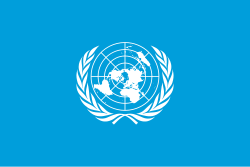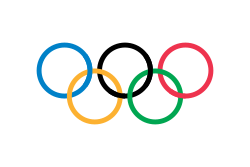Star Trek
In Star Trek science fiction media franchise created by Gene Roddenberry, Earth is governed by a single world government, the United Earth, which itself is a founding member of the United Federation of Planets. [48]
In 1991 Star Trek VI: The Undiscovered Country film, set in the year 2293, the flag of the United Earth consists of two equally-sized horizontal stripes, of red and blue colour, with an equilateral triangle at the hoist. Within the white triangle is placed the emblem that features a planet, and rising sun behind it, placed within the light blue circle. It depicts the top half of the globe, placed in the bottom portion of the emblem. The planet includes a coordinate grid, and fictional white landmasses. Behind the globe is depicted a top half of a yellow sixteen-pointed star rising over the planet. [48]
In the fourth season of the 2001 Star Trek: Enterprise television series, set in the year 2154, the flag of the United Earth depicts an emblem that includes a circle depicting a map of the world, centred on the prime meridian, and one olive branch placed to the left of the map. The boundary of the circle, landmasses and the branch are colour in golden colour, while the water on the map, in dark blue. The emblem is placed on the white background, slightly off-center to the right. Above and below the emblem are two thin horizontal lines, that consist of small parallelogram placed next to each other. The flag and emblem appears in the episodes "Home", "The Forge", and "Demons". The emblem also appears in the 2020 Star Trek: Lower Decks animated television series, in the episode "An Embarrassment of Dooplers". [48]
In the first season of the 2017 Star Trek: Discovery television series, set in the year 2257, the flag of the United Earth consist of the emblem placed on the dark blue background. The emblem includes a circle depicting a map of the world, centred on the Atlantic Ocean, and one olive branch placed to the left of the map. The boundary of the circle, landmasses and the branch are colour in golden colour, while the water on the map, in dark blue. The flag appears in the episode "Will You Take My Hand?". [48]
In the fourth season of Star Trek: Discovery, set in the year 3190, the Solar System is united under the government of the United Earth and Titan. Its emblem consists of the grey circle with beige boundary. On its right, there are two white circles, placed on the circular lines, symbolizing the two words in the orbits around the Sun, represented in the emblem as a golden half-circle in the top left corner of the emblem. Such emblem appears in the episodes "…But to Connect", and "Coming Home". The alternative version of the emblem shown in the episode "Coming Home" depicts a circle with three smaller circles within it. It includes a circle placed to the right includes a map of the world, centred on the Atlantic Ocean, and two smaller circles placed to its right. [48]
In the second season of the 2020 Star Trek: Picard television series, set in the year 2401, the flag of the United Earth consist of the emblem placed on the white background. The emblem includes a circle depicting a map of the world, centred on the Atlantic Ocean, and one olive branch placed to the left of the map. The boundary of the circle, landmasses and the branch are colour in golden colour, while the water on the map, in dark blue. [48]
The Expanse
In the 2015 science fiction television series The Expanse , set in the 23rd century, the Earth, together with the Moon and several colonies across the Solar System, are governed by the United Nations, that assumed a form of a united world government. Its flag is a modified version of the current flag of the United Nations. It consists of the white emblem placed in the centre, on the dark blue background. The emblem includes a simplified and stylized azimuthal equidistant projection of the world map, centred on the North Pole, with the globe being bisected in the centre by the prime meridian and the International Date Line. The projection of the map extends to 60 degrees south latitude, and includes four concentric circles, with an empty space left in the place, where the most inner circle should be. As such it depicts altered coast lines of the landmasses. Around the map is placed a circle, with eight smaller circles event distributed around its subconference. They symbolize the lunar phase, and depicts, from the top clockwise, the first quarter, waxing crescent, new moon, waning crescent, last quarter, waning gibbous, full moon, and waxing gibbous. The elements are inscribed in a wreath consisting of crossed conventionalized branches of the olive tree, which then, are inscribed in two rows of circular lines, cut vertically in the middle. Above the map, between the space left by the lines, are three five-pointed stars, with the middle one, placed higher than the remaining two. Below the emblem, is inscribed text in the white capital letters, that reads "United Nations". [54]


















